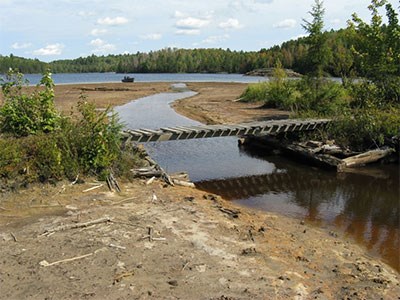The Ministry of Northern Development and Mines (MNDM) is working this summer on finding a solution to the higher-than-acceptable arsenic levels detected in Long Lake in Sudbury.
Elevated levels of the carcinogen were found in the west end of the lake in 2012, following testing done at the urging of the Long Lake Stewardship Committee.
Arsenic was detected in the west end of the lake, near Luke Creek, which leads directly from the old tailings of the Long Lake Gold Mine.
In operation from 1909 to 1916, the mine was, at one point, the largest gold-producing mine in Ontario.
Long Lake is one of several heritage mine sites in the province currently on the ministry’s priority list, said Gordon MacKay, the ministry’s director of mineral development and lands. Established in 1999, the list gives priority to sites that are a threat to human health and to the environment.
“Right now we’ve got 10 projects we’re working on actively on reclaiming across the province,” McKay said. “The total list of orphaned and abandoned sites is obviously a lot higher than that, but the vast majority of those are not either a hazard to humans or the environment, but sites that we do want to get to and address and clean up.”
Work has already begun at Long Lake, for which a consulting firm has been commissioned to determine where exactly the arsenic is coming from.
“We know it’s coming from the tailings, but we need to know how much and where, and then to determine all the possible options to rehabilitate the site, and then ultimately to come up with the best option,” said Chris Hamblin, the ministry’s mine rehabilitation, inspection and compliance co-ordinator.
Detailed engineering plans for the preferred option will be drawn up over the next year, followed by the actual rehabilitation work, he added. It’s difficult to determine how long a cleanup will take until the ministry knows exactly what the problem is, but it’s estimated the study itself will take the rest of the year, and the consulting team will present its recommendations by the end of 2013.
Some remedial work has been done at the site, and the ministry is seeing a reduction in arsenic levels. “This spring we put in some sediment control measures to reduce the amount of sediment being carried by the water draining off the old mine site to reduce that sediment load going into the very south end of Long Lake,” MacKay said.
“A recent sampling indicates that arsenic levels are a little bit lower in the lake, so I don’t know if that’s just the way the weather’s gone or if the measures are having some effect.”
Consultation is ongoing with the stewardship committee, a local cottagers’ association and the Whitefish Lake First Nation, which is actually conducting water sampling in conjunction with the ministry.
Much of the rehabilitation work needed in the province is centred in Northern Ontario, where most of early 19th century mining took place, MacKay said.
In those early days, towns and communities were built up around the mines, which makes it challenging to find solutions in cleaning up some of the heritage mine sites.
But at some sites, the fact that mining is ongoing has proved to be a benefit.
“The good news about Sudbury, and it goes for Timmins also, is the spectacular nature of the ore deposits means the ore deposits are still being mined,” MacKay said. “So now the industry has actually addressed a lot of the problems that were created in the past and, as we’re moving forward, we’ve got a much more environmentally sensitive approach.”
The largest cleanup effort to date was the zinc-copper Kam Kotia Mine, located about 35 km northwest of Timmins, which was operated by the Wartime Metal Corp., a government agency producing brass shell casings during the Second World War in 1943-1944.
That effort cost $54 million and several years to clean up the 500-hectare footprint.




